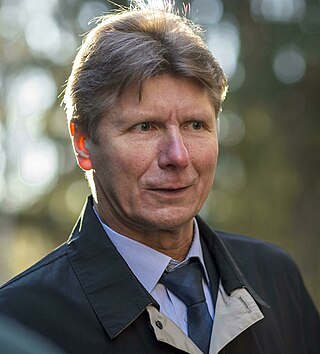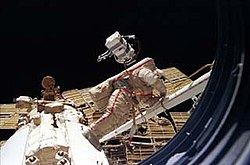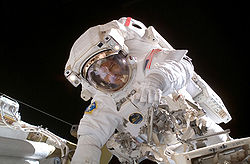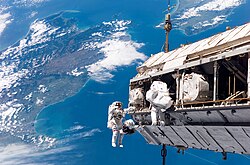
Extravehicular activity (EVA) is any activity done by an astronaut in outer space outside a spacecraft. In the absence of a breathable Earthlike atmosphere, the astronaut is completely reliant on a space suit for environmental support. EVA includes spacewalks and lunar or planetary surface exploration. In a stand-up EVA (SEVA), an astronaut stands through an open hatch but does not fully leave the spacecraft. EVAs have been conducted by the Soviet Union/Russia, the United States, Canada, the European Space Agency and China.

Yuri Ivanovich Malenchenko is a retired Russian cosmonaut. Malenchenko became the first person to marry in space, on 10 August 2003, when he married Ekaterina Dmitrieva, who was in Texas, while he was 240 miles (390 km) over New Zealand, on the International Space Station. As of December 2023, Malenchenko ranks third for career time in space due to his time on both Mir and the International Space Station (ISS). He is a former commander of the International Space Station.

Michael López-Alegría is an astronaut, test pilot and commercial astronaut with dual nationality, American and Spanish; a veteran of three Space Shuttle missions and one International Space Station mission. He is known for having performed ten spacewalks so far in his career, presently holding the second longest all-time EVA duration record and having the fifth-longest spaceflight of any American at the length of 215 days; this time was spent on board the ISS from September 18, 2006, to April 21, 2007. López-Alegría commanded Axiom-1, the first ever all-private team of commercial astronaut mission to the International Space Station, which launched on April 8, 2022, and spent just over 17 days in Earth's orbit.

Peggy Annette Whitson is an American biochemistry researcher, and astronaut working for Axiom Space. She retired from NASA in 2018, after serving as Chief Astronaut. Over all her missions, Whitson accumulated a total of 675 days in space, more than any other American or woman.

Valery Grigoryevich Korzun is a former Russian cosmonaut. He has been in space twice totalling 381 days. He has also conducted four career spacewalks.

Gennady Ivanovich Padalka is a Russian Air Force officer and Roscosmos cosmonaut. Padalka is the only person to have served as the commander of the International Space Station (ISS) four times. He previously held the record for the most time spent in space at 878 days until Oleg Kononenko broke this record on February 4, 2024 at 07:30:08 UTC and is currently at 2nd position. He worked on both Mir and the International Space Station.

Mikhail Vladislavovich Tyurin is a former Russian cosmonaut who flew several missions to the International Space Station and completed four spacewalks during his career. He was awarded the title Hero of the Russian Federation for his work as a cosmonaut.

Fyodor Nikolayevich Yurchikhin is a Russian cosmonaut of Pontic Greek descent, engineer and RSC Energia test-pilot who has flown on five spaceflights. His first spaceflight was a 10-day Space Shuttle mission STS-112. His second was a long-duration stay aboard the International Space Station (ISS) as a flight engineer for Expedition 15; for this mission he was launched in the Soyuz TMA-10 spacecraft. He has undertaken two further long-duration stays aboard the ISS, as a crew member of Expedition 24 / 25. For this mission he was launched with the spacecraft Soyuz TMA-19, and he landed in November 2010, also with the Soyuz TMA-19 spacecraft. He served as Soyuz commander for his fourth mission aboard Soyuz TMA-09M, as flight engineer for Expedition 36 and ISS commander for Expedition 37. In April 2017, Yurchikhin launched on Soyuz MS-04 for the fifth spaceflight of his career, a six-month mission to the ISS as part of Expedition 51 and 52, for which he was the commander.

Pavel Vladimirovich Vinogradov is a former cosmonaut and commander of the International Space Station. He has flown into space three times, aboard Mir and the International Space Station, and was one of the top 10 astronauts in terms of total time in space after his third spaceflight. Vinogradov has also conducted seven spacewalks in his cosmonaut career, and holds the record for the oldest person to perform a spacewalk.

The Orlan space suit is a series of semi-rigid one-piece space suit models designed and built by NPP Zvezda. They have been used for spacewalks (EVAs) in the Russian space program, the successor to the Soviet space program, and by space programs of other countries, including NASA.

Expedition 14 was the 14th expedition to the International Space Station (ISS). Commander Michael López-Alegría, and flight engineer Mikhail Tyurin launched from Baikonur Cosmodrome on 18 September 2006, 04:09 UTC, aboard Soyuz TMA-9. They joined Thomas Reiter, who had arrived at the ISS on 6 July 2006 aboard Space Shuttle Discovery during mission STS-121. In December 2006, Discovery mission STS-116 brought Sunita Williams to replace Reiter as the third member of Expedition 14. On 21 April 2007, López-Alegría and Tyurin returned to Earth aboard TMA-9. Landing occurred at 12:31:30 UTC.

Expedition 16 was the 16th expedition to the International Space Station (ISS). The first two crew members, Yuri Malenchenko and Peggy Whitson, launched on 10 October 2007, aboard Soyuz TMA-11, and were joined by spaceflight participant Sheikh Muszaphar Shukor, the first Malaysian in space.

Sergey Nikolayevich Ryazansky is a Russian cosmonaut. He was selected as commander of the IMBP-6 cosmonaut group in 2003, but later transferred to the TsPK Cosmonaut Group. Ryazansky made his first spaceflight aboard the Soyuz TMA-10M/Expedition 37/Expedition 38 mission from September 2013 until March 2014. In 2017, Ryazansky returned to space was the commander of Soyuz MS-05, and served as Flight Engineer for Expedition 52 / 53.

Expedition 63 was the 63rd long duration mission to the International Space Station, which began on 17 April 2020 with the undocking of the Soyuz MS-15 spacecraft and continued until the undocking of the Soyuz MS-16 spacecraft on 21 October 2020, an unusual double-length expedition increment. The expedition initially consisted of American commander Chris Cassidy, as well as Russian flight engineers Anatoli Ivanishin and Ivan Vagner. On 31 May 2020, the expedition welcomed the crew of Crew Dragon Demo-2, the first crewed flight of SpaceX's Crew Dragon spacecraft, named Endeavour after the eponymous Space Shuttle vehicle. The mission's two crew members Doug Hurley and Bob Behnken undocked from the International Space Station on 1 August 2020 to help bolster research on the station and participate in several spacewalks outside of the station.

Expedition 64 was the 64th long-duration expedition to the International Space Station (ISS) that began on 21 October 2020 with the undocking and departure of Soyuz MS-16. The expedition started with the three crew members who launched onboard Soyuz MS-17 and reached its full complement with the arrival of SpaceX Crew-1, the first operational flight of NASA's Commercial Crew Program (CCP). As Crew-1 consists of a crew of four instead of three like the Soyuz, Expedition 64 marks the beginning of operations for crews of seven on the ISS. In the final week of the mission, Soyuz MS-18 and its three person crew joined the mission. The expedition ended on 17 April 2021 with the departure of Soyuz MS-17.


















